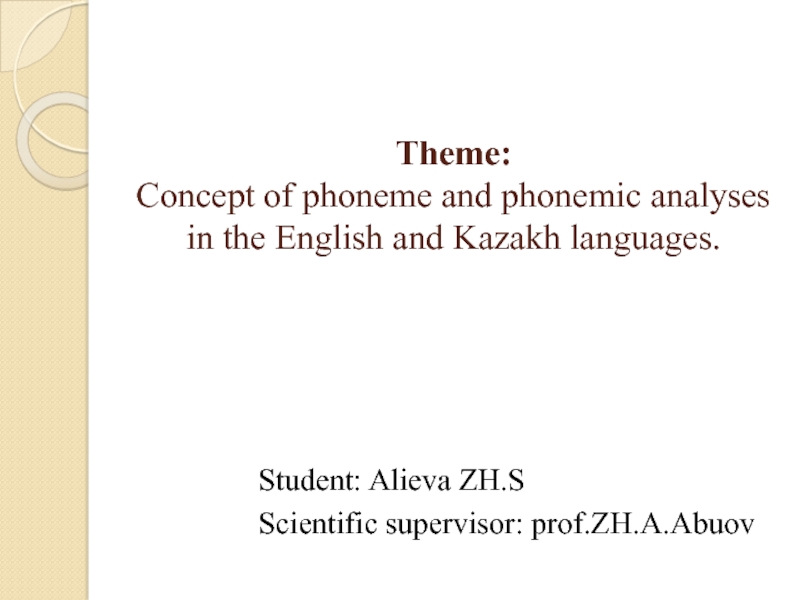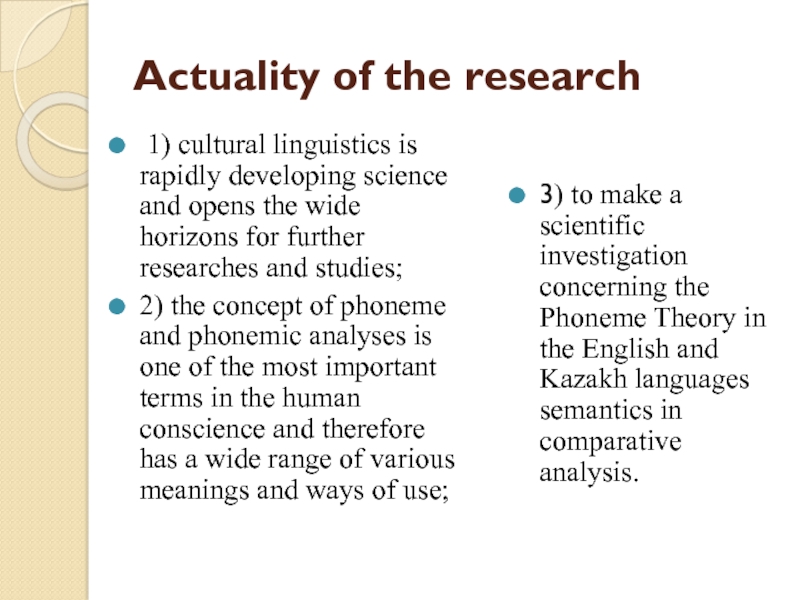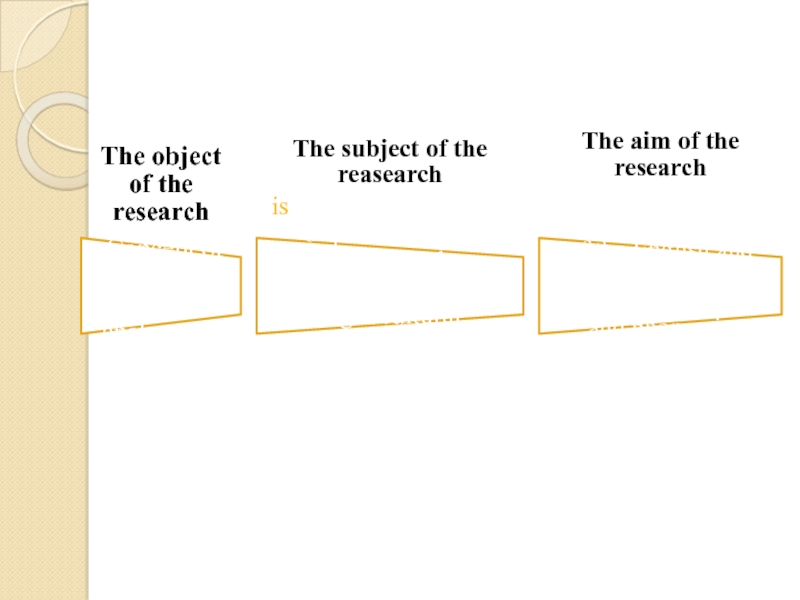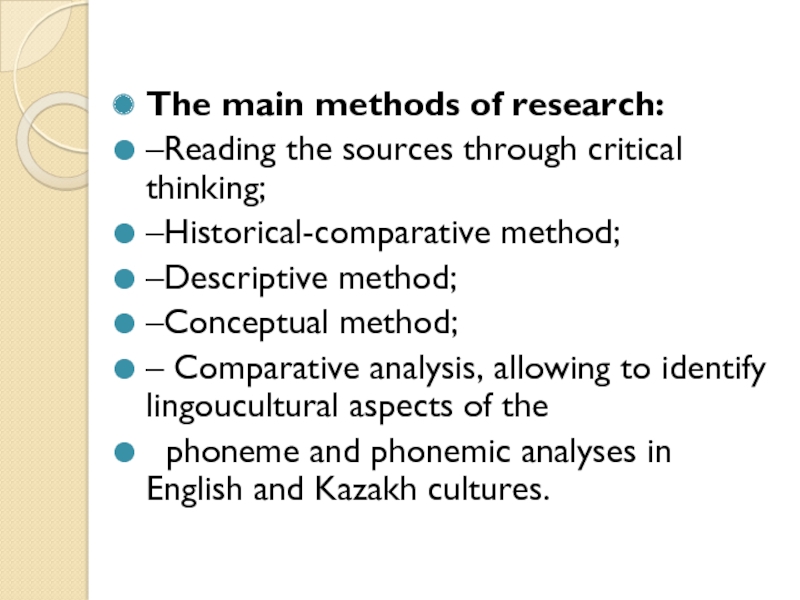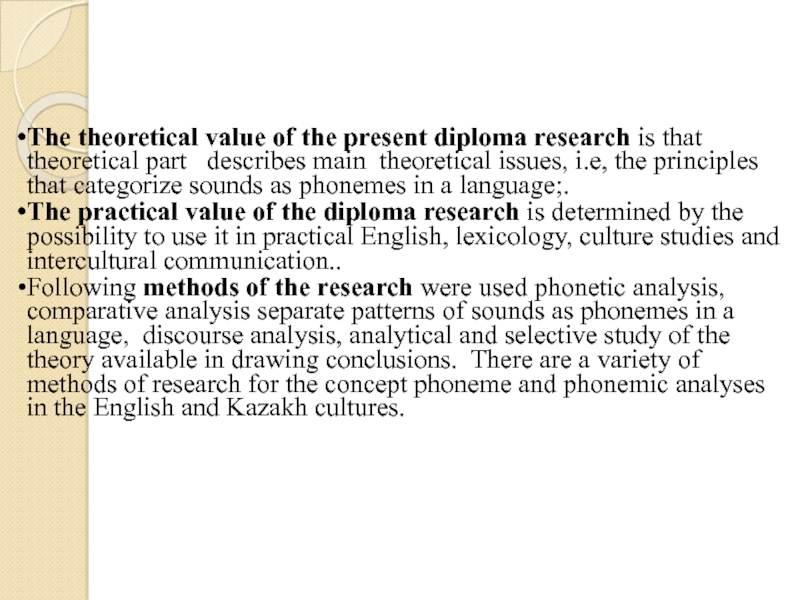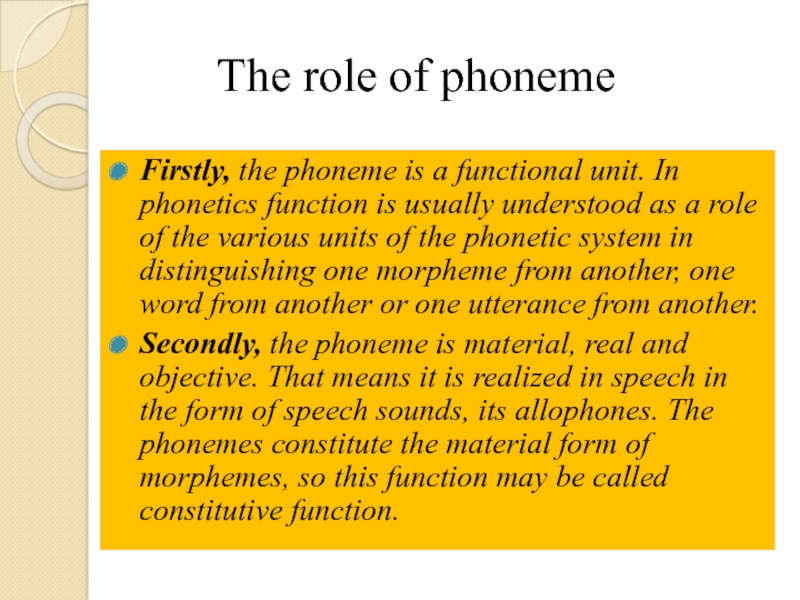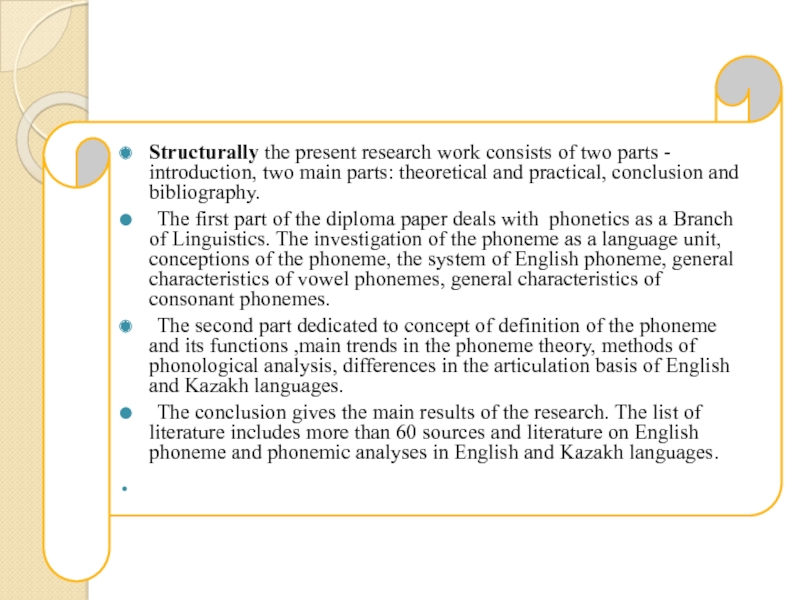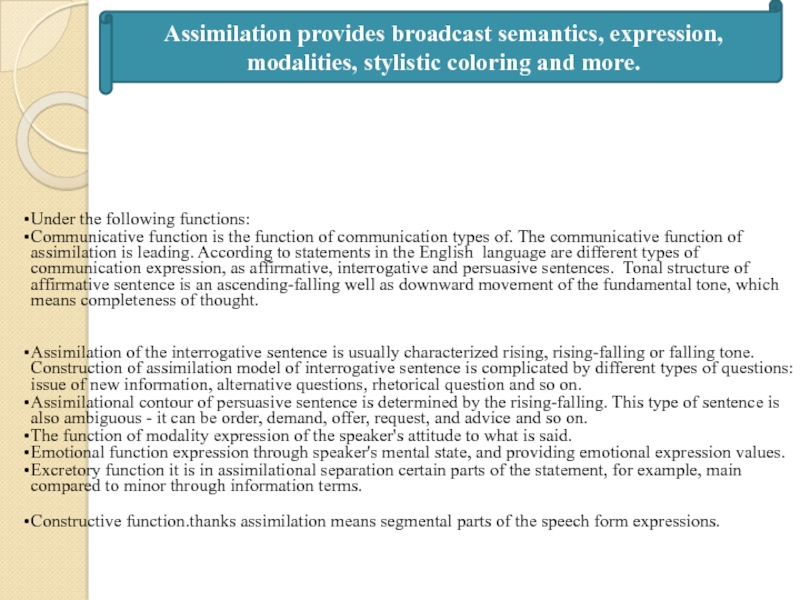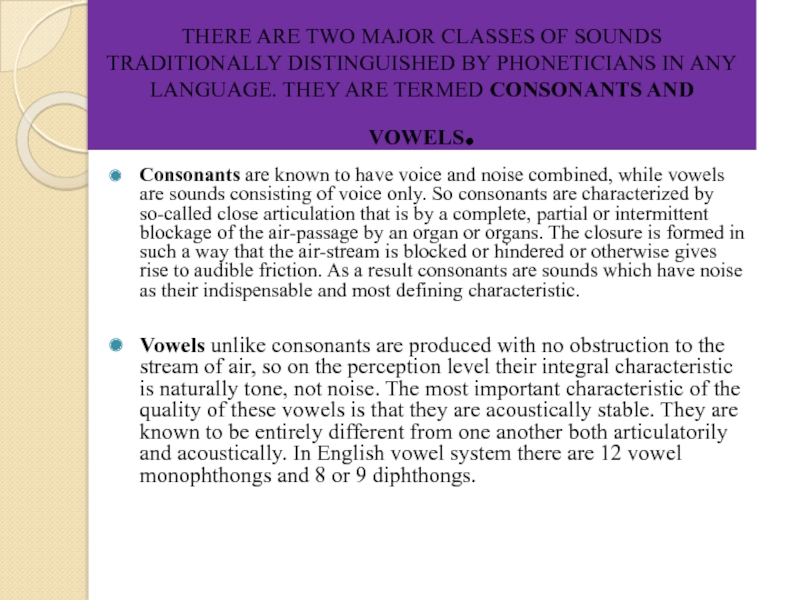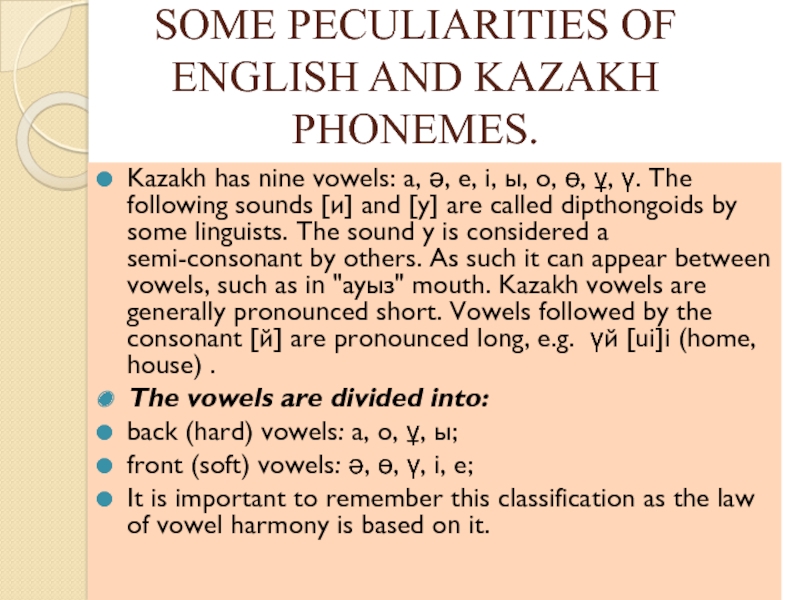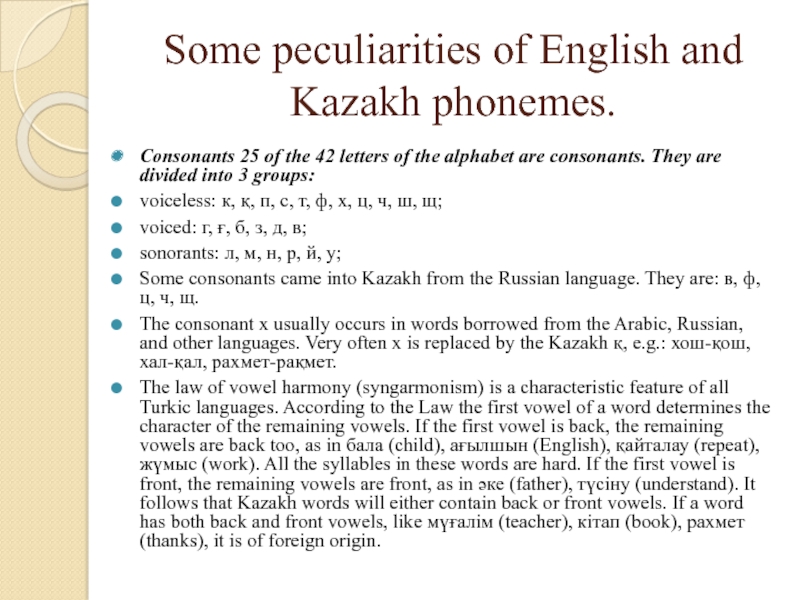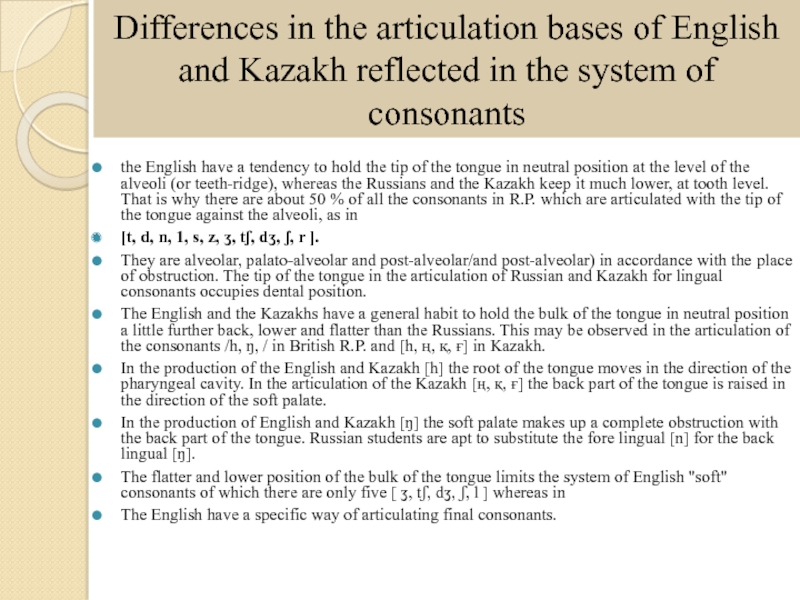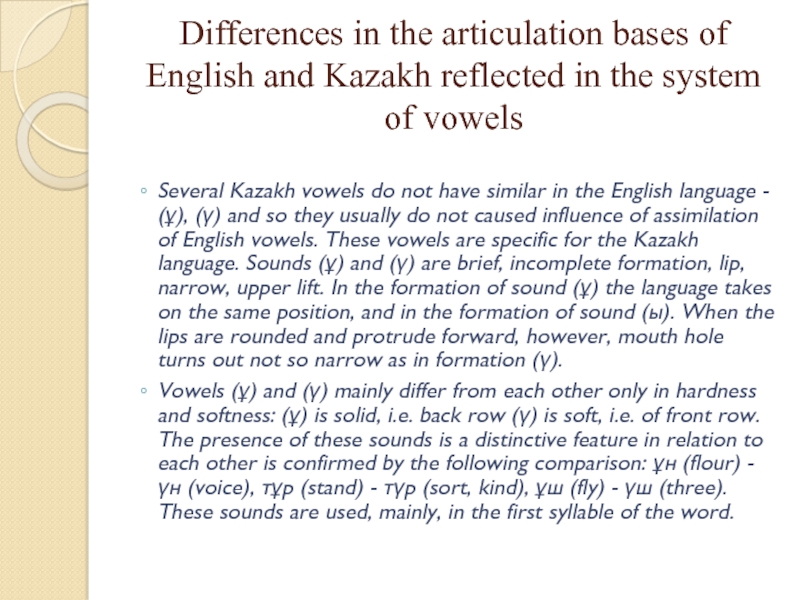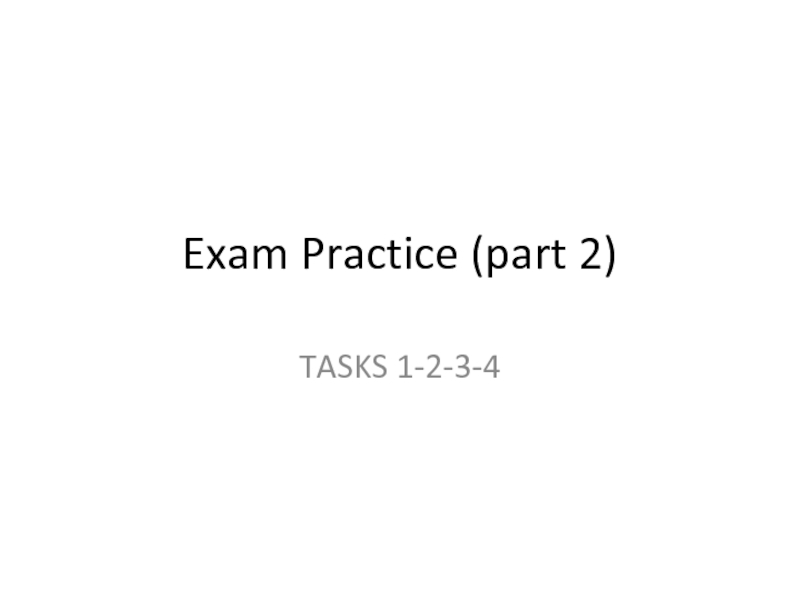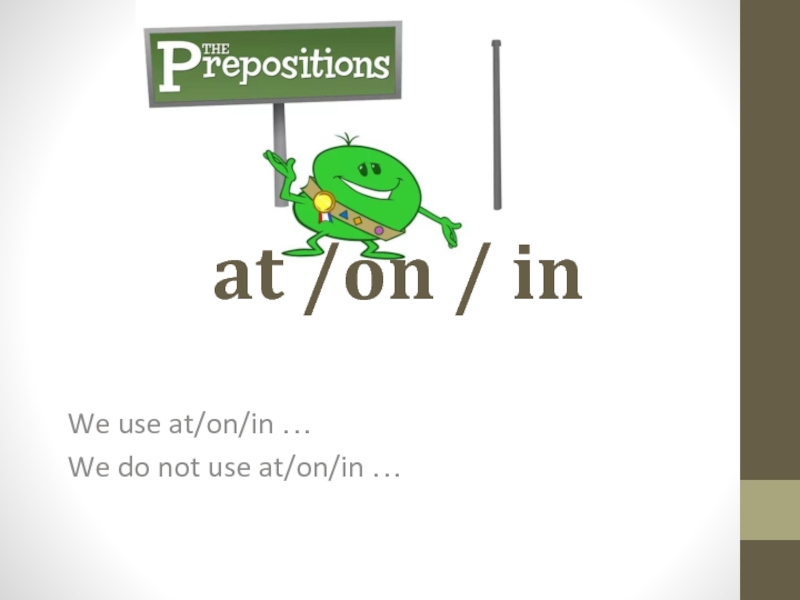Student: Alieva ZH.S
Scientific supervisor: prof.ZH.A.Abuov
- Главная
- Разное
- Дизайн
- Бизнес и предпринимательство
- Аналитика
- Образование
- Развлечения
- Красота и здоровье
- Финансы
- Государство
- Путешествия
- Спорт
- Недвижимость
- Армия
- Графика
- Культурология
- Еда и кулинария
- Лингвистика
- Английский язык
- Астрономия
- Алгебра
- Биология
- География
- Детские презентации
- Информатика
- История
- Литература
- Маркетинг
- Математика
- Медицина
- Менеджмент
- Музыка
- МХК
- Немецкий язык
- ОБЖ
- Обществознание
- Окружающий мир
- Педагогика
- Русский язык
- Технология
- Физика
- Философия
- Химия
- Шаблоны, картинки для презентаций
- Экология
- Экономика
- Юриспруденция
Concept of phoneme and phonemic analyses in the English and Kazakh languages презентация
Содержание
- 1. Concept of phoneme and phonemic analyses in the English and Kazakh languages
- 2. Actuality of the research
- 3. The object of the research Concept
- 4. The aim of the research puts
- 5. The main methods of research: –Reading the
- 6. The theoretical value of the present diploma
- 7. The role of
- 8. Structurally the present research work consists
- 9. Assimilation provides broadcast semantics, expression, modalities,
- 10. THERE ARE TWO MAJOR CLASSES OF
- 11. SOME PECULIARITIES OF ENGLISH AND KAZAKH PHONEMES.
- 12. Some peculiarities of English and Kazakh phonemes.
- 13. Differences in the articulation bases of English
- 14. Differences in the articulation bases of English
- 15. According to the law of vowel harmony
Слайд 1 Theme: Concept of phoneme and phonemic analyses in the English and Kazakh
Слайд 2
Actuality of the research
1) cultural linguistics is rapidly developing
2) the concept of phoneme and phonemic analyses is one of the most important terms in the human conscience and therefore has a wide range of various meanings and ways of use;
3) to make a scientific investigation concerning the Phoneme Theory in the English and Kazakh languages semantics in comparative analysis.
Слайд 3
The object of the research
Concept of phoneme and phonemic analyses in
The subject of the reasearch
is to study the concept of phoneme and phonemic analyses from the point of linguocultural, cognitive and historical aspects in order to show the internal structure of the category of phoneme.
The aim of the research
is to study and research the system of the English and Kazakh through the concept of phoneme and phonemic analyses with the help of the cognitive and linguocultural aspects.
Слайд 4
The aim of the research puts forward the following tasks to
To study research works connected with the concept phoneme and phonemic analyses;
- To study the relationship between language and culture through critical thinking.;
To collect enough material from the existing sources;
Identify lingoucultural aspects of the concept phoneme and phonemic analyses in the English and Kazakh cultures;
To compare two cultures through the concept;
Слайд 5The main methods of research:
–Reading the sources through critical thinking;
–Historical-comparative method;
–Descriptive
–Conceptual method;
– Comparative analysis, allowing to identify lingoucultural aspects of the
phoneme and phonemic analyses in English and Kazakh cultures.
Слайд 6The theoretical value of the present diploma research is that theoretical
The practical value of the diploma research is determined by the possibility to use it in practical English, lexicology, culture studies and intercultural communication..
Following methods of the research were used phonetic analysis, comparative analysis separate patterns of sounds as phonemes in a language, discourse analysis, analytical and selective study of the theory available in drawing conclusions. There are a variety of methods of research for the concept phoneme and phonemic analyses in the English and Kazakh cultures.
Слайд 7 The role of phoneme
Firstly, the phoneme is
Secondly, the phoneme is material, real and objective. That means it is realized in speech in the form of speech sounds, its allophones. The phonemes constitute the material form of morphemes, so this function may be called constitutive function.
Слайд 8
Structurally the present research work consists of two parts - introduction,
The first part of the diploma paper deals with phonetics as a Branch of Linguistics. The investigation of the phoneme as a language unit, conceptions of the phoneme, the system of English phoneme, general characteristics of vowel phonemes, general characteristics of consonant phonemes.
The second part dedicated to concept of definition of the phoneme and its functions ,main trends in the phoneme theory, methods of phonological analysis, differences in the articulation basis of English and Kazakh languages.
The conclusion gives the main results of the research. The list of literature includes more than 60 sources and literature on English phoneme and phonemic analyses in English and Kazakh languages.
Слайд 9
Assimilation provides broadcast semantics, expression, modalities, stylistic coloring and more.
Under the
Communicative function is the function of communication types of. The communicative function of assimilation is leading. According to statements in the English language are different types of communication expression, as affirmative, interrogative and persuasive sentences. Tonal structure of affirmative sentence is an ascending-falling well as downward movement of the fundamental tone, which means completeness of thought.
Assimilation of the interrogative sentence is usually characterized rising, rising-falling or falling tone. Construction of assimilation model of interrogative sentence is complicated by different types of questions: issue of new information, alternative questions, rhetorical question and so on.
Assimilational contour of persuasive sentence is determined by the rising-falling. This type of sentence is also ambiguous - it can be order, demand, offer, request, and advice and so on.
The function of modality expression of the speaker's attitude to what is said.
Emotional function expression through speaker's mental state, and providing emotional expression values.
Excretory function it is in assimilational separation certain parts of the statement, for example, main compared to minor through information terms.
Constructive function.thanks assimilation means segmental parts of the speech form expressions.
Слайд 10 THERE ARE TWO MAJOR CLASSES OF SOUNDS TRADITIONALLY DISTINGUISHED BY PHONETICIANS
Consonants are known to have voice and noise combined, while vowels are sounds consisting of voice only. So consonants are characterized by so-called close articulation that is by a complete, partial or intermittent blockage of the air-passage by an organ or organs. The closure is formed in such a way that the air-stream is blocked or hindered or otherwise gives rise to audible friction. As a result consonants are sounds which have noise as their indispensable and most defining characteristic.
Vowels unlike consonants are produced with no obstruction to the stream of air, so on the perception level their integral characteristic is naturally tone, not noise. The most important characteristic of the quality of these vowels is that they are acoustically stable. They are known to be entirely different from one another both articulatorily and acoustically. In English vowel system there are 12 vowel monophthongs and 8 or 9 diphthongs.
Слайд 11SOME PECULIARITIES OF ENGLISH AND KAZAKH PHONEMES.
Kazakh has nine vowels: а,
The vowels are divided into:
back (hard) vowels: а, о, ұ, ы;
front (soft) vowels: ә, ө, ү, і, е;
It is important to remember this classification as the law of vowel harmony is based on it.
Слайд 12Some peculiarities of English and Kazakh phonemes.
Consonants 25 of the 42
voiceless: к, қ, п, с, т, ф, х, ц, ч, ш, щ;
voiced: г, ғ, б, з, д, в;
sonorants: л, м, н, р, й, у;
Some consonants came into Kazakh from the Russian language. They are: в, ф, ц, ч, щ.
The consonant х usually occurs in words borrowed from the Arabic, Russian, and other languages. Very often х is replaced by the Kazakh қ, e.g.: хош-қош, хал-қал, рахмет-рақмет.
The law of vowel harmony (syngarmonism) is a characteristic feature of all Turkic languages. According to the Law the first vowel of a word determines the character of the remaining vowels. If the first vowel is back, the remaining vowels are back too, as in бала (child), ағылшын (English), қайталау (repeat), жүмыс (work). All the syllables in these words are hard. If the first vowel is front, the remaining vowels are front, as in әке (father), түсіну (understand). It follows that Kazakh words will either contain back or front vowels. If a word has both back and front vowels, like мүғалім (teacher), кітап (book), рахмет (thanks), it is of foreign origin.
Слайд 13Differences in the articulation bases of English and Kazakh reflected in
the English have a tendency to hold the tip of the tongue in neutral position at the level of the alveoli (or teeth-ridge), whereas the Russians and the Kazakh keep it much lower, at tooth level. That is why there are about 50 % of all the consonants in R.P. which are articulated with the tip of the tongue against the alveoli, as in
[t, d, n, 1, s, z, ʒ, tʃ, dʒ, ʃ, r ].
They are alveolar, palato-alveolar and post-alveolar/and post-alveolar) in accordance with the place of obstruction. The tip of the tongue in the articulation of Russian and Kazakh for lingual consonants occupies dental position.
The English and the Kazakhs have a general habit to hold the bulk of the tongue in neutral position a little further back, lower and flatter than the Russians. This may be observed in the articulation of the consonants /h, ŋ, / in British R.P. and [h, ң, қ, ғ] in Kazakh.
In the production of the English and Kazakh [h] the root of the tongue moves in the direction of the pharyngeal cavity. In the articulation of the Kazakh [ң, қ, ғ] the back part of the tongue is raised in the direction of the soft palate.
In the production of English and Kazakh [ŋ] the soft palate makes up a complete obstruction with the back part of the tongue. Russian students are apt to substitute the fore lingual [n] for the back lingual [ŋ].
The flatter and lower position of the bulk of the tongue limits the system of English "soft" consonants of which there are only five [ ʒ, tʃ, dʒ, ʃ, l ] whereas in
The English have a specific way of articulating final consonants.
Слайд 14Differences in the articulation bases of English and Kazakh reflected in
Several Kazakh vowels do not have similar in the English language - (ұ), (ү) and so they usually do not caused influence of assimilation of English vowels. These vowels are specific for the Kazakh language. Sounds (ұ) and (ү) are brief, incomplete formation, lip, narrow, upper lift. In the formation of sound (ұ) the language takes on the same position, and in the formation of sound (ы). When the lips are rounded and protrude forward, however, mouth hole turns out not so narrow as in formation (ү).
Vowels (ұ) and (ү) mainly differ from each other only in hardness and softness: (ұ) is solid, i.e. back row (ү) is soft, i.e. of front row. The presence of these sounds is a distinctive feature in relation to each other is confirmed by the following comparison: ұн (flour) - үн (voice), тұр (stand) - түр (sort, kind), ұш (fly) - үш (three). These sounds are used, mainly, in the first syllable of the word.
Слайд 15According to the law of vowel harmony in a single word
көл (lake), ән (song) are soft, қoл (hand), жан (the soul) are hard.
In this case, of soft are added affixes with vowels only from the front row, for example, in сен - дер - дeн (from you), and added to the hard affixes with vowels only from back row: ба - лa - лар - ды (children – accusative case.).
Whereas the English language, there is complete independence of vowels and affixes the end of the vowel root, alternation vowels of front row with vowels of back row in the same word (army, answer, public, language).
Thus, the system of English vowels is marked the large number of contrasts than in Kazakh. So, there is no similarity between Kazakh and English vowels:[60]
1) mixed sound of the front and back row, and
2) long and short; monophtong - diphthong.
Nowadays, English is taught in many schools and high schools in the Kazakh Republic. Since the students will eventually learn English on the basis of mother tongue, there is a need for a number of research tools based on a comparison of phonetics, vocabulary and grammar of English and Kazakh languages. The given research is considered the issues of teaching English pronunciation in attracting of such comparisons. In the practice of language teaching two ways of teaching pronunciation are mainly distributed. The first is based on imitation, i.e. by unconscious assimilation of phonetic phenomenon. On the basis of second is a meaningful learning.
We consider that since the students will eventually learn English on the basis of mother tongue, there is a need for a number of research tools based on a comparison of phonetics, vocabulary and grammar of English and native languages. Students need to maintain awareness of the linguistic features of foreign speech to the development of skills.
.
Conclusion
